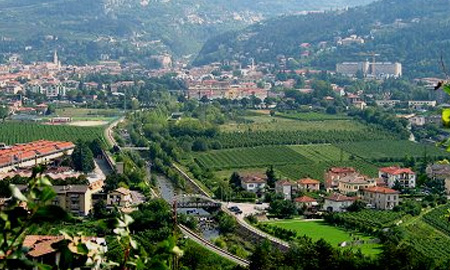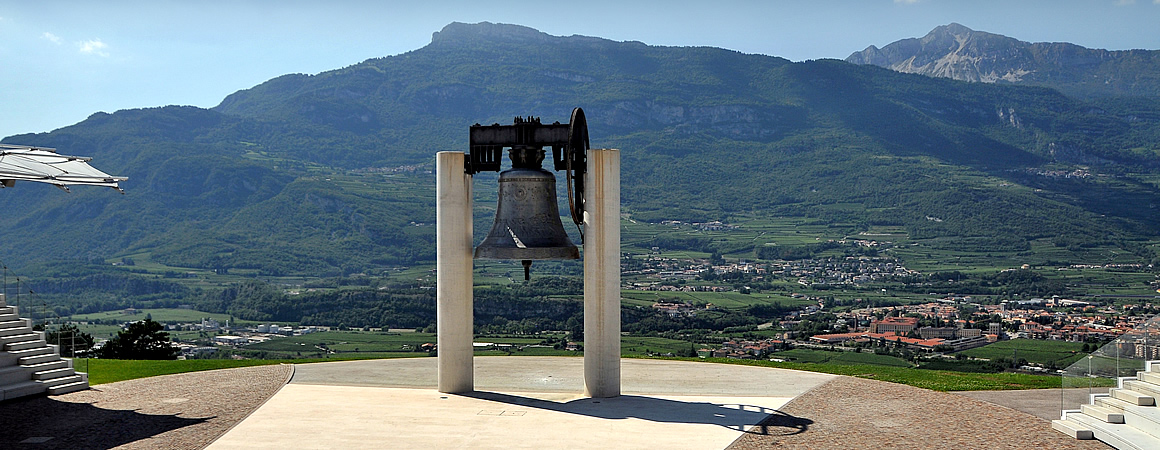THE PAST THIRTY YEARS The 8 September of 1968 - that year filled with controversy - also saw the death aged 92 of the sculptor Stefano Zuech, the creator of the wonderful bas-reliefs that adorned the outside of the first Bell and were later repeated for the second and third castings. The same year saw the fiftieth anniversary of the end of the First World War, and to mark the occasion a 45 rpm disc was recorded with the ringing of the holy bronze bell.
On 2 November, the 50th anniversary of "the Victory" as it was called in those days, a solemn ceremony took place at the Ossuary and the Bell. The Trento celebrations were attended by the President of the Republic, Giuseppe Saragat, who was initially expected to come to Rovereto too. Instead it was announced that the Prime Minister, Giovanni Leone, would attend; but in the end the city had to be content with the Rovereto-born Minister for Mercantile Marine, Giovanni Spagnolli, who attended the official commemoration under a leaden sky and often persistent rain, which partially prevented the mass attendance of the general public. On 4 November, the RAI TV news programme at 20:30 broadcast a live recording of the ringing of Maria Dolens, thus acceding to a proposal put forward in the press by a discharged former lieutenant of the bombardiers, Giuseppe Ferrari of Mondovì, a battalion companion of Damiano Chiesa. He was given the honour of pressing the button to start the Bell on this historic evening. 
ROVERETO, CITY OF PACE
In December 1970, in the initial stages of a lengthy judiciary process, the Council of Ministers approved a bill which granted a contribution of 200 million lire to the Opera Campana dei Caduti for the definitive restoration of the Bell in accordance with the design made in 1964 by architect Luciano Baldessari, and 50 million for the more urgent task of refurbishing the castle granted to the Municipality of Rovereto, owner of the building that houses the War Museum. The measure was then ratified by Parliament and published in the Official Gazette on 7 August 1971 . The granting of these funds and their division between the two bodies had the effect of rekindling the old controversy, but more than anything, the ongoing legal dispute effectively blocked any initiative, forcing the Baldessari project to be mothballed. During the 1975 Jubilee, the Regency organised the
"International Day of Remembrance for all the Fallen”,
with a pilgrimage which was joined by the ambassadors of some forty nations and the exponents of twenty or so religious confessions and denominations. This culminated at the foot of Maria Dolens on 14 September, with a moving ceremony embracing Catholicism, Greek Orthodoxy, Evangelism, Lutheranism, Judaism, Islam and Buddhism. From Rovereto, the pilgrimage moved to Trento, then Assisi, before concluding in Rome with a special audience with Pope Paul IV and the President of the Republic, Giovanni Leone. The event was enormously well-received, and its importance gave a boost to the ideal of peace, respect and union between all peoples of the world, over and above the ideologies of different religions, which the Bell in its role of symbol of peace was intended to promote through the actions of Father Jori and the entire Regency.
THE BELL PROMOTES PEACE
In those years, Maria Dolens was the destination of huge numbers of visitors, with peaks of up to 100,000 a year. At the foot of the Bell the most heterogeneous groups assembled: from CB radio users and bikers to the March of Nations in July 1980 and the 7th European congress of war veterans, held 15-17 May 1981, which brought to Rovereto approximately 10,000
former combatants from all over Europe, who assembled under the great Bell in a sign of peace and opposition to war, with the motto: “If you want peace, prepare peace".
Even the Honourable Enrico Berlinguer, secretary of the Italian Communist Party, climbed Miravalle hill to pay his respects to the Bell of the Fallen on 5 November 1983.






